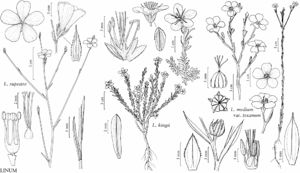Difference between revisions of "Linum kingii"
Botany (Fortieth Parallel), 49. 1871.
FNA>Volume Importer |
imported>Volume Importer |
||
| (3 intermediate revisions by 2 users not shown) | |||
| Line 10: | Line 10: | ||
|special_status={{Treatment/ID/Special_status | |special_status={{Treatment/ID/Special_status | ||
|code=F | |code=F | ||
| − | |label= | + | |label=Illustrated |
}}{{Treatment/ID/Special_status | }}{{Treatment/ID/Special_status | ||
|code=E | |code=E | ||
| Line 19: | Line 19: | ||
|name=Cathartolinum kingii | |name=Cathartolinum kingii | ||
|authority=(S. Watson) Small | |authority=(S. Watson) Small | ||
| + | |rank=species | ||
}} {{Treatment/ID/Synonym | }} {{Treatment/ID/Synonym | ||
|name=Mesyniopsis kingii | |name=Mesyniopsis kingii | ||
|authority=(S. Watson) W. A. Weber | |authority=(S. Watson) W. A. Weber | ||
| + | |rank=species | ||
}} | }} | ||
|hierarchy=Linaceae;Linum;Linum sect. Linopsis;Linum kingii | |hierarchy=Linaceae;Linum;Linum sect. Linopsis;Linum kingii | ||
| Line 46: | Line 48: | ||
-->{{#Taxon: | -->{{#Taxon: | ||
name=Linum kingii | name=Linum kingii | ||
| − | |||
|authority=S. Watson | |authority=S. Watson | ||
|rank=species | |rank=species | ||
| Line 60: | Line 61: | ||
|publication title=Botany (Fortieth Parallel), | |publication title=Botany (Fortieth Parallel), | ||
|publication year=1871 | |publication year=1871 | ||
| − | |special status= | + | |special status=Illustrated;Endemic |
| − | |source xml=https:// | + | |source xml=https://bitbucket.org/aafc-mbb/fna-data-curation/src/2e0870ddd59836b60bcf96646a41e87ea5a5943a/coarse_grained_fna_xml/V12/V12_498.xml |
|genus=Linum | |genus=Linum | ||
|section=Linum sect. Linopsis | |section=Linum sect. Linopsis | ||
Latest revision as of 19:15, 5 November 2020
Herbs, perennial, caudex woody, 5–30 cm, glabrous and glaucous. Stems ascending to erect from decumbent base, branched from base. Leaves: alternate throughout or proximal opposite, divergent, erect or spreading; stipular glands absent; blade narrowly lanceolate, 5–25 × 1–3 mm, thick (basal leaves), margins entire, not ciliate, apex rounded to subacute; 1-nerved. Inflorescences panicles or thyrses. Pedicels 1–5 mm. Flowers: sepals persistent, lanceolate to ovate or broadly oblong, 2.5–4.5 mm, margins not scarious, inner glandular-toothed, outer entire or sparsely glandular-toothed near apex, apex acute to ± obtuse, not acuminate; petals bright yellow, oblanceolate to obovate, 5–12 mm; stamens 3–8 mm; anthers 1.5–2.5 mm; staminodia absent; styles distinct, 4–7 mm; stigmas capitate. Capsules ovoid-pyriform, 2.3–4 × 2.8–3.6 mm, apex pointed (easily crushed), freely dehiscing into 10, 1-seeded segments, segments persistent on plant, false septa incomplete, proximal margins ciliate. Seeds 2–2.7 × 1–1.4 mm. 2n = 26.
Phenology: Flowering May–Aug.
Habitat: Open slopes, often on barren alkaline clay or rocky calcareous substrates.
Elevation: 1400–3400 m.
Distribution

Colo., Idaho, Nev., Utah, Wyo.
Discussion
Linum kingii is low, compact, and much branched. All parts of the flowers are yellow. The corolla is nearly rotate, the petals are abruptly narrowed to a claw, the styles are at right angles to the flower axis, and the anthers are relatively large. Linum kingii is extremely variable in habit and in size of floral and vegetative parts, even within a population or within a single plant (C. M. Rogers 1984).
Selected References
None.
